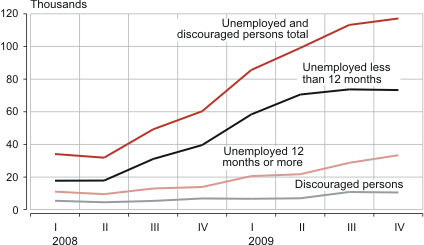Long-term unemployment is increasing
According to the data of the Estonian Labour Force Survey, in the 4th quarter of 2009 the estimated number of unemployed persons was 107,000, which is two times more than in the same quarter of 2008. The annual average number of unemployed persons was 95,000 and the unemployment rate 13.8% in 2009, which is the largest during the period after the restoration of independence in Estonia. In 2000, the year of the largest unemployment so far, the number of unemployed persons was 90,000 and the unemployment rate 13.6%.
In the previous year, the unemployment increased most in the 1st quarter. With every following quarter the growth of the unemployment slowed down. As the number of new unemployed persons continuously decreased, the number of unemployed persons who have been seeking for a job less than a year did not grow anymore in the last quarter. At the same time the number of long-term unemployed persons grew rapidly. In the 4th quarter, 33,000 unemployed had been looking for a job for 12 months or more.
Besides the growth of long-term unemployment, the number of discouraged persons also increased in the second half of the year. In the 3rd quarter, 11,000 persons had stopped seeking a job because they did not expect to find one. The number of discouraged persons was the same also in the 4th quarter. It is remarkable that the unemployment rate of non-Estonians is almost two times bigger than that of Estonians, but Estonians stop job seeking more easily. In 2009, half of the long-term unemployed were non-Estonians, but among discouraged persons only one fifth were non-Estonians.
Unemployed by duration of unemployment and discouraged persons, 2008–2009
The number of employed persons decreased to 581,000 in the 4th quarter of the previous year. The annual average number of employed persons was 596,000 in 2009, which is 61,000 (9.2%) less than in 2008. The employment decreased in most of economic activities. The decrease was the biggest in construction (28%), other service activities (22%), manufacturing (16%), accommodation and food service activities (15%) and trade (10%).
The disappearances of jobs and long-term unemployment have been continuously deepening difficulties in coping of the unemployed people and their household members. In the 4th quarter of 2009 less than half of persons aged 15–74 estimated their coping as satisfactory. The share of people coping with some difficulties increased to 37% and the share of people coping with great difficulties increased to 16% (to 164,000). Due to the unemployment of parents also more and more children are in difficult economic situation. The number of children (less than 18 years of age) in the jobless households was 37,000 in the 4th quarter of 2009, which is over two times more than a year ago.
Unemployment rate is the share of the unemployed in the labour force (sum of employed and unemployed persons). The estimates are based on the data of the Labour Force Survey. Statistics Estonia has been conducting the Labour Force Survey since 1995 and every quarter 5,000 persons participate in it. The Labour Force Survey is carried out by statistical organisations in all European Union Member States on the basis of harmonised methodology.
